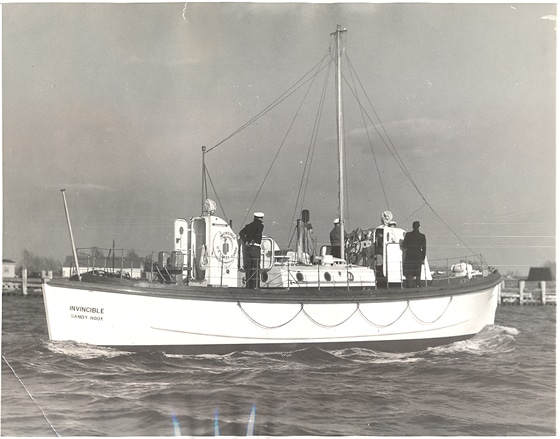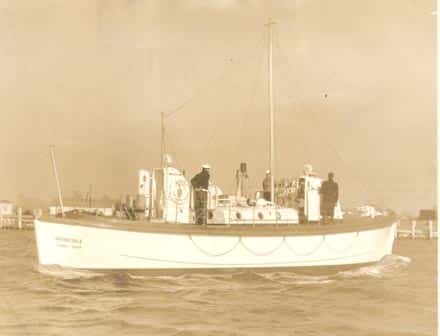11484. (photo) U.S. Coast Guard 52′ MLB Invincible, CG-52300 c.1935
Welcome to Kenrick A. Claflin & Son
Featured on our web site and in our monthly web catalogues are new and out-of-print books, documents, post cards, photographs, maps and charts, engravings, lithographs, uniforms and insignia, tools, lamps, lens apparatus, equipment and apparatus and much more relating to these heroic services.
We now issue most of our catalogues on line rather than by mail. This allows us to issue more catalogues and feature more items, with better photos and descriptions. Let us know your email address and we will email you monthly as our catalogues are posted.
Type in your search word. After hitting Enter you will automatically be brought back to this page. Scroll down to this spot to see the results of search. Pages containing your search word will be listed. You will be allowed to click on the pages found. When on each page, Windows Explorer will allow you to use Ctrl + F to bring up a search box for that page. Type in your search word again and hit “Enter”. You will be taken to that item.
11484. (photo) U.S. Coast Guard 52′ MLB Invincible, CG-52300 c.1935
11484. (photo) U.S. Coast Guard 52′ MLB Invincible, CG-52300 c.1935. The first of its class of 52-foot motor lifeboats, boat No. 4000, later named Invincible, was completed in Fiscal Year 1936. The 52-foot motor lifeboat originally designated as “Type F” class was a developmental design. There were only two built, the Invincible and her sister, the Triumph, CG-52301. These craft were given an improved cruising radius over the standard 36-foot class of motor lifeboats, a more powerful engine, and accommodations for crew and for rescued survivors. The 52-footer was not self-bailing or self-righting, but her initial stability was very high. The superstructure, including the wheelhouse, engine-room trunk, companionway, and the survivor compartments were constructed of bronze. The hull was divided into six watertight compartments, any two of which could be flooded and the boat would remain afloat. The watertight bulkheads were made of bronze and both were all welded construction. They were designed by the Coast Guard and both were built at the Coast Guard Yard. Sixty persons could be carried below in their watertight compartments and additional 100 could be carried on deck, weather permitting. They were not intended to replace the standard 36-foot class of motor lifeboats, but rather were designed to meet the need for a larger, more powerful lifeboat for use at locations with extreme sea conditions. During their time in service, they were the only Coast Guard craft under 100-feet in length that received names. The Invincible was initially stationed at Sandy Hook, New Jersey, but transferred to Grays Harbor Lifeboat Station in 1941. She was transferred to Coos Bay Lifeboat Station sometime later. 7” x 9”. Dated April 19, 1935. Includes description and credit line on back. Rare view. (VG). $46.
11484d. (photo) U.S. Coast Guard 52′ MLB Invincible, CG-52300 c.1936. The first of its class of 52-foot motor lifeboats, boat No. 4000, later named Invincible, was completed in Fiscal Year 1936. The 52-foot motor lifeboat originally designated as “Type F” class was a developmental design. There were only two built, the Invincible and her sister, the Triumph, CG-52301. These craft were given an improved cruising radius over the standard 36-foot class of motor lifeboats, a more powerful engine, and accommodations for crew and for rescued survivors. The 52-footer was not self-bailing or self-righting, but her initial stability was very high. The superstructure, including the wheelhouse, engine-room trunk, companionway, and the survivor compartments were constructed of bronze. The hull was divided into six watertight compartments, any two of which could be flooded and the boat would remain afloat. The watertight bulkheads were made of bronze and both were all welded construction. They were designed by the Coast Guard and both were built at the Coast Guard Yard. Sixty persons could be carried below in their watertight compartments and additional 100 could be carried on deck, weather permitting. They were not intended to replace the standard 36-foot class of motor lifeboats, but rather were designed to meet the need for a larger, more powerful lifeboat for use at locations with extreme sea conditions. During their time in service, they were the only Coast Guard craft under 100-feet in length that received names. The Invincible was initially stationed at Sandy Hook, New Jersey, but transferred to Grays Harbor Lifeboat Station in 1941. She was transferred to Coos Bay Lifeboat Station sometime later. 7” x 9”. Dated April 23, 1935. Includes description and credit line on back. Rare view. (VG). $46.


